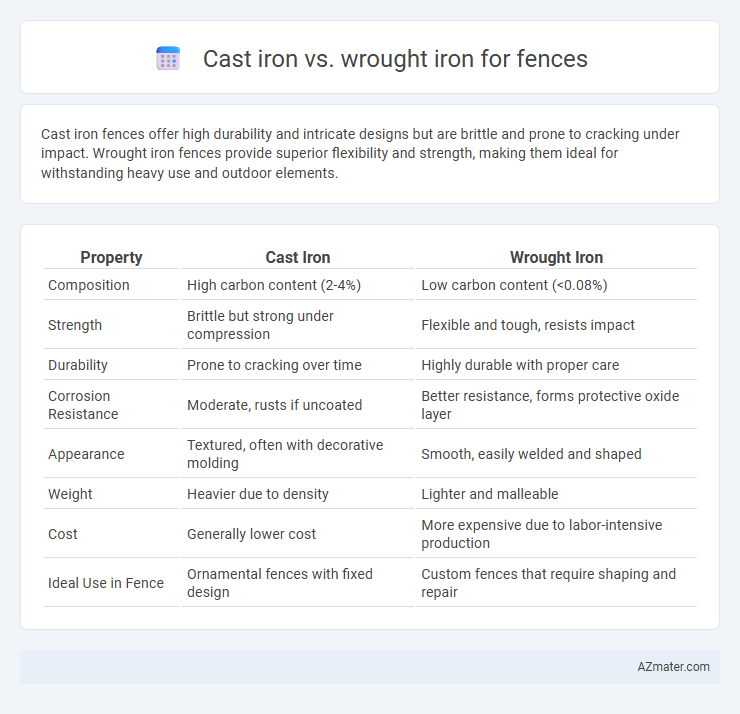Cast iron fences offer high durability and intricate designs but are brittle and prone to cracking under impact. Wrought iron fences provide superior flexibility and strength, making them ideal for withstanding heavy use and outdoor elements.
Table of Comparison
| Property | Cast Iron | Wrought Iron |
|---|---|---|
| Composition | High carbon content (2-4%) | Low carbon content (<0.08%) |
| Strength | Brittle but strong under compression | Flexible and tough, resists impact |
| Durability | Prone to cracking over time | Highly durable with proper care |
| Corrosion Resistance | Moderate, rusts if uncoated | Better resistance, forms protective oxide layer |
| Appearance | Textured, often with decorative molding | Smooth, easily welded and shaped |
| Weight | Heavier due to density | Lighter and malleable |
| Cost | Generally lower cost | More expensive due to labor-intensive production |
| Ideal Use in Fence | Ornamental fences with fixed design | Custom fences that require shaping and repair |
Introduction to Cast Iron and Wrought Iron Fences
Cast iron fences offer exceptional durability and intricate design possibilities due to their high carbon content, providing a classic and ornamental appearance that withstands harsh weather conditions. Wrought iron fences are known for their malleability and toughness, featuring low carbon content that allows for detailed craftsmanship and flexibility in design while maintaining structural strength. Both materials are popular choices for fencing, with cast iron focusing on decorative appeal and wrought iron prized for its strength and customization.
Historical Use and Popularity
Cast iron fences gained popularity during the Victorian era for their ornate designs and mass production capabilities, making them a symbol of industrial advancement and decorative appeal. Wrought iron, valued for its malleability and strength, has been favored since medieval times for its durability and classic handcrafted look, often used in historic estates and public buildings. Both materials maintain significant cultural heritage value, with cast iron preferred for intricate, decorative fencing and wrought iron celebrated for robust, long-lasting structural applications.
Material Composition and Manufacturing Processes
Cast iron fences consist primarily of carbon (2-4%) combined with iron, produced by melting and pouring into molds, resulting in a brittle yet strong structure ideal for intricate designs. Wrought iron contains less carbon (below 0.1%) with fibrous slag inclusions, made through heating and hammering, which creates a ductile and malleable material suited for durable, handcrafted fences. The differences in carbon content and manufacturing--casting versus forging--directly affect the fence's strength, flexibility, and ornamental detail capabilities.
Strength and Durability Comparison
Cast iron fences offer excellent compressive strength but tend to be brittle and prone to cracking under impact, making them less durable in harsh environments. Wrought iron, known for its superior tensile strength and flexibility, withstands heavy loads and resists bending or breaking, resulting in longer-lasting fences. The corrosion resistance and weldability of wrought iron further contribute to its durability compared to the more brittle and less malleable cast iron.
Design Flexibility and Aesthetic Appeal
Cast iron fences offer intricate, detailed designs thanks to their ability to be molded into complex shapes, providing high aesthetic appeal with ornate patterns and classical elegance. Wrought iron fences excel in design flexibility through manual forging, allowing custom, unique shapes and creative, handcrafted details that enhance rustic charm and timeless style. Both materials deliver strong visual impact, but cast iron emphasizes intricate decorative motifs while wrought iron favors versatile, artisanal craftsmanship for personalized fence designs.
Maintenance Requirements and Longevity
Cast iron fences require minimal maintenance due to their ability to resist rust, while wrought iron fences demand regular upkeep, including sanding and painting to prevent corrosion. Longevity of cast iron fences can extend up to 50 years with proper care, whereas wrought iron fences, though more prone to rust, can also last several decades if maintained diligently. Both materials offer substantial durability, but cast iron's dense composition provides superior resistance to environmental wear, reducing overall maintenance efforts.
Cost Differences and Value for Money
Cast iron fences typically cost more upfront due to intricate designs and heavier material, while wrought iron offers a more affordable installation with comparable durability. Wrought iron provides better value for money, balancing strength, corrosion resistance, and ease of maintenance over time. Cast iron's brittleness can lead to higher repair costs, making wrought iron the preferred choice for long-term investment in fencing.
Suitability for Residential vs. Commercial Projects
Cast iron fences offer intricate designs and high durability, making them ideal for decorative residential projects that require aesthetic appeal and moderate security. Wrought iron fences provide superior strength and flexibility, suited for commercial applications demanding robust protection and long-lasting performance under heavy usage. The choice depends on balancing ornamental value for homes versus strength and security needs in commercial environments.
Environmental Impact and Sustainability
Cast iron fences have a higher carbon footprint due to energy-intensive production processes involving melting and casting, while wrought iron manufacturing is less energy-intensive, often involving forging and shaping by hand. Both materials are highly durable and recyclable, contributing to long-term sustainability by reducing the need for frequent replacements. Wrought iron's lower processing emissions and potential for repair make it a more environmentally sustainable choice for fences compared to cast iron.
Choosing the Right Iron for Your Fence
When choosing between cast iron and wrought iron for your fence, consider that wrought iron offers superior malleability and durability, making it ideal for custom designs and intricate patterns. Cast iron is more brittle but provides a historically authentic, ornate look with less fabrication effort. Prioritize wrought iron for long-lasting strength and flexibility in design, while cast iron suits decorative purposes with less structural demand.

Infographic: Cast iron vs Wrought iron for Fence
 azmater.com
azmater.com